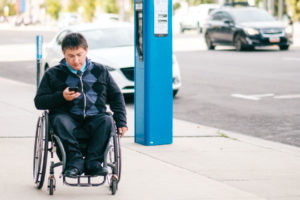By Renee Smith, JD MBA
Canada’s cities have long struggled with how to make their streets (and sidewalks and neighborhoods) more accessible to people with disabilities. There are many barriers to handicap access, including curbs bordering sidewalks, paucity of parking spaces designated solely for use by people with disabilities, and inaccessible buses and other forms of public transportation for people who don’t want to drive into the heart of the city. Add to that snow drifts, which are a common presence on our streets and sidewalks, and it’s easy to understand why it can be so difficult for people with disabilities to often struggle in our cities.
One area where cities sometimes fall short when it comes to accessibility is parking. That’s because it’s easy to fall into the trap of only addressing the most obvious accessibility issues, such as the size and location of parking spaces for people with disabilities. These are obviously important issues, but they only address part of the issue.
For many cities accessibility often ends at the curb cut. Parking planners tend to do a good job of making it easy to find appropriate parking and get safely out of vehicles and onto sidewalks. However, they don’t always give as much thought to their parking equipment, particularly meters and parking payment machines.
Impossible To Use
Not all parking equipment is designed with the needs of people with disabilities in mind, and older equipment can be particularly problematic. It’s often too tall or poorly designed for them to use, particularly those in wheelchairs. With the advent of pay-on-foot systems and smart meters, payment kiosks have become a common sight in cities. Unfortunately drivers with disabilities, particularly those in wheelchairs, sometimes can’t use these meters and kiosks because the credit card slots and cash receptacles in the equipment…
By Danielle Desjardins
One of the greatest environmental challenges our cities face today lies in mobility. The economic and social fabric of urban environments are closely intertwined with networks of vehicles and transportation systems that leave their mark: around one-quarter of global CO2 emissions come from the transportation of people and goods.
How should the parking industry adapt to a future in which major cities may deploy various strategies meant to diminish the number of private vehicles on their main thoroughfares, thus diminishing the need for parking spaces?
If you commuted to work by car in Montreal or Toronto in 2017, chances are you spent the equivalent of a normal work week being stuck in traffic. According to the Inrix Traffic Scorecard Rank1, commuters from these cities wasted respectively 50 and 47 hours being in a car immobilized by congestion.
As the population grows and more people move into urban areas, overwhelmingly choosing the suburbs over downtowns, traffic jams worsen and commuting to work becomes a never-ending nightmare. Hence a growing trend in major cities to implement various strategies and impose new rules to ease the gridlock and get people moving again.
For instance, many cities are banning cars from their centers: Oslo has pledged to do it by 2019, Madrid wants to do it in 2020, while cities like Rome, Dusseldorf and Stuttgart are planning to ban diesel cars in the near future.2 Other cities, like London, plan to create streets and street networks that encourage walking, cycling and public transport use in order to reduce car dependency3. Add this to other recent developments, like the proliferation of ride-sharing and car-sharing services and the advent of driverless cars getting people to work and returning home to park4, and you have the perfect storm for a decline in demand for parking garage services.
Embarking…
By Jessica Bates
A decade from now, many of us could be commuting to work in cars that drive themselves. For some, this sounds like science fiction; others can’t imagine willingly handing over the wheel to a computer. Nonetheless, driverless cars are almost certainly coming to a road near you, and they are likely to transform how we work and live in more ways than we can predict.
Driverless cars—also called autonomous cars or self-driving cars—are unmanned vehicles capable of sensing their environments and navigating without any human input. Early versions of these cars already exist and they are becoming more reliable and sophisticated every day. Commercial building owners and managers need to start thinking about how the autonomous vehicle revolution will affect their properties—from the loss of parking revenue to new development opportunities to the potential increase in tenant amenities.
THE TIPPING POINT
Cities already are starting to see significant shifts in commuter behavior with the rise of ride-sharing services, such as Uber and Lyft. More and more young people are entering the workforce without owning a car—or even having a driver’s license. J.F. Finn, III, AIA, principal and studio director for architecture and design firm Gensler, believes these behaviors will accelerate the rise in self-driving vehicles. “My nephews and nieces have no interest in car ownership—it doesn’t represent freedom and autonomy the way it has to previous generations,” Finn explains. “Many people are getting around just fine these days without the costs and inconveniences of owning their own car.”
Gensler’s research team predicts that, by 2021, ride-sharing services will become the dominant form of transportation, at least in urban centers. He calls this the “tipping point” where large numbers of autonomous vehicles become realistic. While today’s autonomous cars still require some human oversight, there is widespread optimism that fully autonomous cars will…





